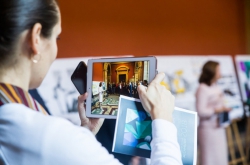I founded teamLab in 2001, having worked as an engineer in the field of humanoid robots and AI before that. My interest in art motivated me to gather a team in order to create various visual installations in the field of digital art. Today we have five partner companies and there are 500 employees, including engineers, programmers, mathematicians, graphic designers, and creative specialists, working at our office in Tokyo. All of our projects are made in groups; we draw inspiration from natural images, as nature brings out the emotions that one can’t describe with words and can only be felt with one’s body. We are also inspired by works of Japanese artists who paint flowers and natural objects.
What is most important in digital or technological art
The most important feature of technological art is that you get to experience it with your body. Traditional art is more about observing objects from afar. We, on the contrary, create installations that you don’t just observe, but also interact with. For instance, we have the art installation Wandering Through Crystal Universe. A person enters a labyrinth where the walls change color according to what they choose on their smartphone; when passing through the rooms, one feels as though they glide through the universe. We wanted to make it so that the viewer would experience the feeling of being lost in this space, some illusion of endlessness.
We also have the interactive installation Strokes of Life which we installed at a trade center in Singapore. We placed a huge display on the floor that people could walk upon. When they moved, lines of calligraphic strokes followed their paths, and butterflies would fly towards them. With this digital canvas, people themselves became artists, and could “draw” together by interacting in such a way that the lines would intercross and form patterns.
Such interactions don’t necessarily imply using light. In our installation Floating Flowers Garden for the National Museum of Emerging Science and Innovation in Tokyo, we had real orchids hanging down from the ceiling. People entered the room, and wherever they walked, the orchids would rise above them , thus forming a kind of a sphere around them. If two people came close to each other, the sphere got bigger. The viewers got the feeling that they were surrounded by flowers and fragrant natural scents, i.e. they did not just look at the installation, but felt it, and became a part of it.
Why people are becoming less interested in common visual arts
Now that we have internet to show us any given piece of visual art, we no longer need to go to museums. Because of this, people today strive to experience art that involves all of their senses, and that is why digital art is becoming increasingly more popular. Pretty much the same is happening with music, too. People are interested in going to live concerts where they can see the musicians and meet other people, i.e. interact with art, and not just listening to music at home.
Speaking of music: we had this experience of creating a light installation for one musical festival. Beams of light shone above people, and when someone “touched” a beam, a sound of a particular guitar string could be heard. This way, the audience itself could interact and create music; they became part of the process, part of the festival.
Digital art will help people let go of their smartphones and interact more
We believe that digital art can help people communicate and interact more. Each installation we create is only available in one specific place, and you have to perceive it here and now. This is different from when you put on a VR headset at home and start doing something in a digital environment. In the case of digital art, you have to go somewhere and spend time in the company of other people. This can help us interact with each other better and focus less on our devices.

This reminds me of an interesting case. We were working on an installation in New York, where flowers bloomed on a display when a person came close to it. People could also touch the flowers. At a certain point, there were a great many people in the room, and flowers no longer bloomed. Then, someone in the audience understood what happened, and asked the others to stand back a bit, and when they did, the flowers appeared again. I mean, people started to communicate. There was also another incident that showed how digital art makes people more broadminded and ready to accept something unusual. My friend was setting up an installation in London, and as he didn’t have much sleep in several days he fell asleep in the same room where the exhibition took place. He was still asleep when the exhibition opened, and he slept through the event; people who came to see it photographed him. If he were to fall asleep, for instance, in the Hermitage they would have surely asked him to leave.
Practical applications of digital art
We have a project called An Office Where Animals Live. There’s an office that has lots of conference rooms, and a lot of new people come there every day. We made it so that guests looking for a particular conference room are brought there by digital images of animals. For example, if one needs to find the Hippo conference room, they just have to follow a colourful image of a hippo that slides along the wall. If the guest is to touch the image, it will interact with them, for instance, turn its head. Our clients wanted their employees to be more creative, and decided to motivate them in such a way. This is a good example of how digital art can enhance creative abilities.
Digital art in education
We also have projects aimed at children. In one of them, children can work together to build a city. They place special bricks on a touch-sensitive surface, and different elements of a city - buildings, railroads, highways - appear on a screen. This way, they can cooperate and work on ideas in order to create a city they want. Importantly, they don’t compete but rather interact with each other in order to reach a common goal. They also get to learn about how a city infrastructure works.
In another project for children, we stimulate children's creative ability and spatial intelligence. First, children draw fish or any other sea creatures. Then we digitize their drawings and “release” them into a digital fish tank. There, the drawings come to life and interact with each other, and the children can “feed” their fish. We also have a version of this project where we use the 2d drawings to create 3d construction toys: for instance, if a child draws a car, we print it in such a way that they can cut it from paper and fold it into a three-dimensional object.
All our projects for children are designed to be more involving so that children would not just look at some images on ceilings and walls, but interact with them, so that the images and modern technology would be interconnected.

Digital art is about dissolving borders
In digital art, any surface, no matter the size, can be used as canvas. When we draw on paper, the size of an image is limited by this material. But when we use digital technologies, there’s no boundaries in what has to do with the size of your work or its location. For instance, you can set up installations on the walls of buildings or in parks. We also have a project with one restaurant in Tokyo. The food there was served in plates with images of butterflies that would fly away and flutter all over the table. Digital art is all about dissolving borders.
During the World’s Expo 2015 in Milan we were asked to decorate the Japanese pavilion. We created a digital waterfall with images of Japanese food falling downstream. People could place their smartphones in special slots under the waterfall, and touch the images of the foods they liked, prompting images and descriptions of the foods to be downloaded to their smartphones. It helped people become immersed in the art, to take a part of it with them and, perhaps, to try one of the dishes some time later.
We will continue creating digital art in different places, and we are also opening our first Digital Art Museum, which will occupy a space of 10,000 sqm. There will be about 50 installations that will continue on from one room to another: we want to make it so that it would even be possible to get lost in that place. Of course, all of our artworks will interact will the visitors.





